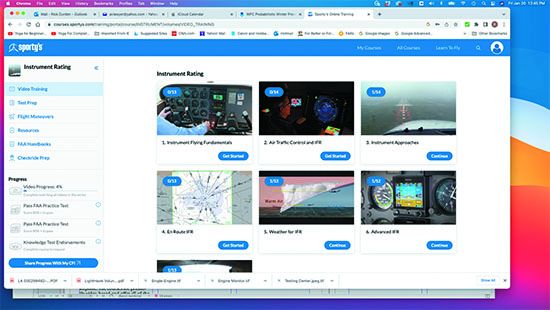We have long been interested in pilot training courses and their content, availability, quality and cost. We watched the quality and ease of use go up dramatically with the advent of the first video courses and get even better as they became internet-based and increasingly interactive.
We pay particular attention to what we consider turnkey video courses—ones that provide all of the ground instruction needed for a rating, FAA knowledge test (aka the written) preparation materials, practice written exams, an endorsement to take the written, videos of all of the required maneuvers and flight/practical test prep. Essentially, the only thing they don’t provide is the training airplane and CFI.
With this article we’re starting a series examining such courses. Our reviews will appear periodically. We’re beginning with the advanced training and ratings needed to fly professionally—the instrument, commercial and multi-engine ratings. Following our review of those courses we’ll look at learn to fly courses for the private ticket.
NOT JUST THE TEST
We have a bias when it comes to training courses for pilots—we are firmly of the opinion that such courses should go we’ll beyond teaching just for the written and checkride—they should include knowledge that will help the pilot survive and thrive in the real world, without digressing endlessly into minutia.
We’re looking for training quality at least as good as a pilot would receive at one of the dedicated—and painfully expensive—programs offered at schools such as Embry-Riddle, Purdue University and University of North Dakota.
Frankly, we’re going looking for top-quality ground training for pilots on a budget.
FREE STUFF
We fully recognize that all of the manuals and reference materials that the FAA created and relies upon in establishing written and practical test content are available for free on the FAA’s website. We are aware that some pilots have the discipline to do their ground training by reading those materials. We are also aware that they constitute a minority and that most learn more effectively from training courses that take a multimedia approach as we’ll as presenting the information in an engaging fashion along with providing easy-to-use links to supporting materials.
The reality is that pilots are willing to spend money for effective training courses. We’re looking to see if that money is we’ll spent.
We’re starting with Sporty’s (www.sportys.com) advanced pilot courses because we have to start somewhere and because it updated its training courses for 2023.
In announcing its 2023 courses, Sporty’s referred to “significant enhancements” to make training more efficient and engaging. Improvements include that the courses can be played on more platforms and have new resources, new videos and new CFI tools.
OVERVIEW
Sporty’s training courses can now be played on virtually all computers and its training app is now available for Apple computers. It can work with or without an internet connection—the Mac app automatically saves test prep components for offline use and videos can be downloaded to the Mac’s hard drive. Progress through a course syncs between all formats so you can use your computer, phone and tablet as we’ll as Apple TV.
CarPlay integration has been added to the iOS version of the pilot training app. According to Sporty’s, pilots use it to listen to the audio training segments from any of the training courses—we think that it’s a good way to review and reinforce information learned while watching the video.
An interactive FAR/AIM tool has been added allowing a search on desired topics. Sporty’s FAR database is updated continually.
In our opinion, any training course should contain a syllabus—which all of Sporty’s do. It improved them for 2023 with quick access to suggested study resources such as video segments and FAA manuals. Each video now has a Related Content tab that links the student to additional videos, FAA publications and helpful websites.
Some years ago Sporty’s started including real-world videos—many inflight—with their courses. Called Air Facts, we liked them because they spent some time explaining how you really do things, helping develop practical skills for such things as dealing with weather. There are more of the Air Facts videos now, on topics we feel are important and that one simply cannot get through FAA publications.
LINKING IN THE CFI
We also like that a pilot taking a Sporty’s course can link her or his flight instructor into the course to monitor student progress but also access video segments, a document library and templates for endorsements. We think giving the CFI access to the course is a great value for both the student and the CFI.
Using Apple’s SharePlay on iOS devices, the student and instructor can watch a training video together while on a FaceTime call. The app syncs the playback so both see the same thing at the same time and can discuss it.
Got a question while working on a course? Sporty’s has CFIs on staff so you can click the “ask a CFI” button, send your question while you are thinking about it—and get an answer quickly.
The courses come with a guarantee that you’ll pass the written, oral and flight tests.
Sporty’s courses also integrate with Flight Schedule Pro, AOPA Flight Training Advantage, your ForeFlight logbook and Redbird GIFT.
Once a person purchases a Sporty’s training course she or he has lifetime access to it, which includes what we consider to be an impressive document library.
INSTRUMENT TRAINING
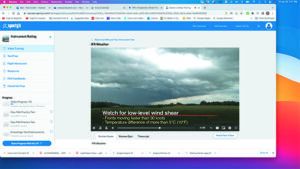
Priced at $279, Sporty’s Instrument Rating Course includes 12 hours of HD video and 3D animations that are packaged in easily digestible segments ranging from five to less than 20 minutes.
The course is broken into seven main chapters, each containing at least a dozen video segments. We like that the very first video creates a bit of excitement about flying IFR—after briefly outlining the content of the course, it jumps right into a flight in IFR conditions from Dayton, Ohio, to Midway Airport in Chicago. It shows how things look from inside as a pilot navigates in the ATC system and handles weather, including the good feeling of breaking out of the clouds and spotting the runway on an approach.
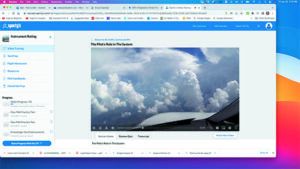
As the course moves into basic instrument flying and how to set up an instrument scan, it shows how to do so with round gauges as we’ll as glass, and explains the why of what a pilot is doing with both flight instrument presentations.
All of the maneuvers for instrument flight, from steep turns through intercepting and tracking navigational systems and holding entries, are set out in a separate section on the course’s navigation bar. It contains 27 videos—we like that it’s a convenient place to find and review how to physically fly IFR. Each video includes a tab to a page that gives the completion standards, written description of the maneuver and common errors.
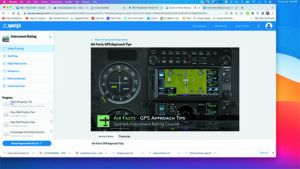
The Weather for IFR chapter takes what can be an insomnia cure and brings it to life with videos of real weather—often severe—and graphics that explain the why of the weather a pilot may face when flying IFR—and what it may do next. Having been involved with the development of understanding microbursts and how to deal with them some 35 years ago, we were impressed with the depth of coverage and explanation of that potentially deadly phenomenon in the course.
The Advanced IFR chapter not only takes a pilot through some of the more complex subjects on the written and practical exams, it goes into depth on things that a pilot is likely to experience after the rating such as operating turbocharged engines, oxygen use, pressurization and flying in the flight levels. Because the one-time purchase of the course means lifetime access—with regular content upgrades—we see it as a resource that a pilot may use for years of IFR flying.
For $279.00, we think this course is a steal.
Sporty’s also offers a Deluxe Instrument Rating Kit for $449.00. Although the explanation on the website is almost completely lacking in details, on top of the instrument training course the kit appears to include a set of Foggles, instrument chart and holding pattern plotter, a digital timer, electronic E6B, two suction cup devices to cover instruments for partial panel training and hard copies of at least three of the books provided as e-books in the underlying course.
In our opinion, it doesn’t look as though there is enough value added to warrant spending the extra money.
COMMERCIAL TRAINING
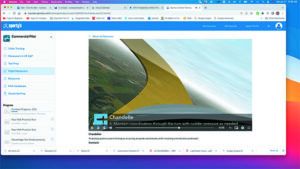
Offered for the same price as its instrument course, $279, Sporty’s Commercial Pilot Training Course includes 13 hours of, in our opinion, concise, feature-rich, interesting content. As with the other courses it can be run on almost any platform and contains impressive resource and document libraries. It has both knowledge test and checkride prep and, in our opinion, does an excellent job of preparing a pilot for the professional aviation world by going beyond the minimum requirements of the FARs.
It consists of six chapters, each with a number of video segments that completely cover the areas of flight procedures and maneuvers, weather, aerodynamics and performance, airplane systems and high-altitude flight, navigation and cross-country and commercial pilot regulations.
If the instrument ticket is the thinking rating, the commercial is the rating where a pilot has to turn into an aviator—has to go from driving an airplane to flying it, with precision, smoothness and a degree of panache.
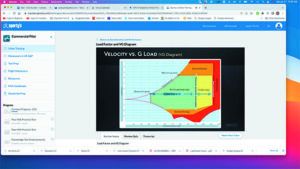
While the touch needed to step up a pilot’s skill level can’t be taught on the ground, the mindset of a passion for precision and an understanding of the need for smoothness can be. In our opinion this course will go a long way toward imbuing the fledgling commercial pilot with the receptiveness needed to learn that smoothness and precision once in the airplane.
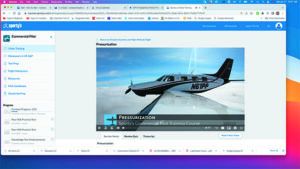
We think Sporty’s does a good job of preparing the student for the quality of flying required for the commercial checkride through its extensive commercial maneuvers and flight maneuvers videos. They explain each maneuver, give completion standards and common errors, but also go into detail regarding the control inputs that will be needed as speed and bank angle change as do the effects of P-factor and overbanking tendency. They go beyond saying that more right rudder is going to be needed right here—they explain why, so that the pilot can be ready for the needs for changing control inputs, having developed an understanding of the aerodynamics involved.
In addition, Sporty’s presents all of the commercial maneuvers with a 360-degree pilot view. That means that as the maneuver is flown, the viewer can rotate the camera to look in any direction, something very valuable in establishing reference points when flying the maneuver.
We had a commercial student approaching her checkride view the maneuver videos. She had previously viewed a number of videos from other training companies. Her comments were that the Sporty’s videos “got right to the point,” “didn’t wander off on tangents” and “didn’t go down weird paths as did some others that dragged out a subject.” She liked that each was about five minutes, “not a half-hour.” She was able to view and absorb all of them in an evening.
She went on to mention that they gave parameters for each maneuver that were straight from the ACS—but that were not in other video training she’d seen. She liked the speaker in the videos—he had an “easy to follow voice, didn’t drone on” and she didn’t “zone out” as she sometimes did watching other video training.
She told us that she was very impressed that Sporty’s used Patty Wagstaff to teach the spin awareness material, and had pilot-eye views of spins.
The aerodynamics and aircraft design discussions are detailed, but easy to understand.
We appreciated that, where applicable, videos showed both round dial flight instruments and glass—and spent time getting into advanced avionics and high-performance and high-altitude operations.
In our opinion, at $279, the course is a bargain.
Sporty’s offers a Deluxe Commercial Pilot Course Kit for $479.00. In addition to the standard course it includes Sporty’s $99.99 multi-engine course, a kneeboard, logbook, an iPad flight bag and hard copies of several of the books included as e-books in the underlying course. Unless you don’t already have hard copies of the books and need a knee board and logbook, we don’t see enough value added to spend the extra bucks.
MULTI-ENGINE TRAINING
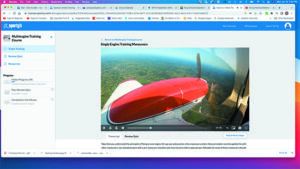
We reviewed Sporty’s Multi-Engine Training Course a few years back and rated it as one of the best that we’ve ever seen. With the 2023 updates and upgrades we continue to be of the opinion that person who spends $99.99 for the course, pays close attention to the two hours of video and does the review quiz will probably have little trouble with the rating. Given the quality of the materials, we also think this course is a bargain.
We’ve conducted multi-engine flight training for many years, yet we found that several areas of the course explained concepts in ways that were so clear that we better understood them—and wished that we’d been able to do that for our students.
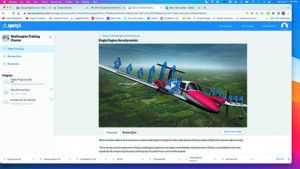
The inflight video and graphics depicting zero sideslip with an engine out make the complex interrelationship of offset thrust, yaw, roll and drag easily understandable.
Graphics are effectively mixed with photos to show system operations such as creating a cutaway of an engine and prop hub to explain the spring and oil mechanism used to control prop RPM and drive the prop into feather when commanded.
We especially liked the graphic of the loss of lift on one wing when its engine (left) takes the day off. A nice touch was to depict smoke coming from the engine to help show that it was in trouble along with the decreased lift vector arrows behind the left prop as the airplane starts to roll left.
We think the course covers nearly everything that a pilot can expect to be asked on the oral exam except for the specifics of the training airplane contained in its POH.
In addition to the solid reference library included with the course, an add-on that we consider valuable is a discussion of a number of “best practices” that a multi-engine pilot will want in her or his tool kit over many years of flying twins.
CONCLUSION
With prices for each of the Sporty’s training courses at or less than we’ve seen for in-person ground schools—not including books—we think the combination of price and quality makes them among the best deals in aviation for pilots seeking ground training for advanced ratings.

